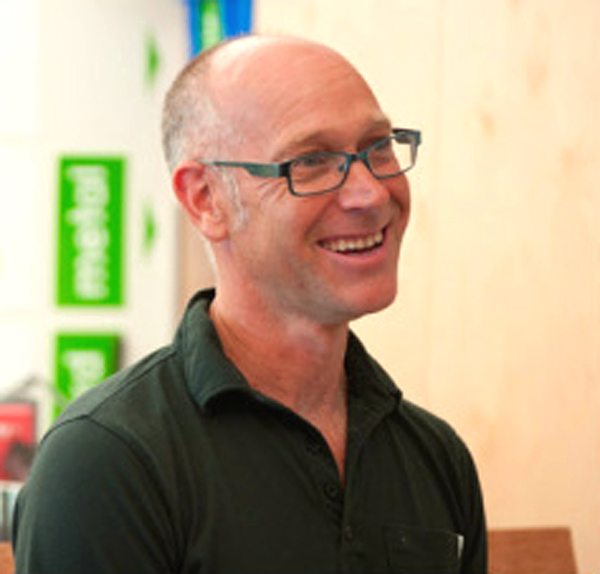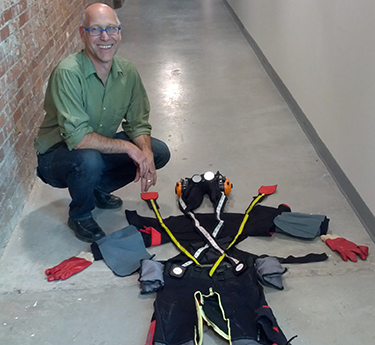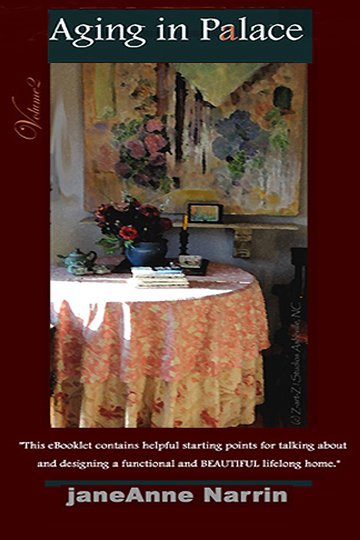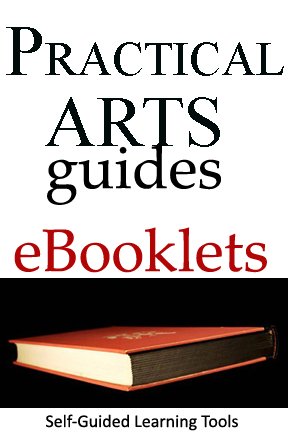GLEN HOUGAN
Elegant Adaptations and Design Innovations

Glen Hougan
In the following interview, a "no sAge limit" designer talks with The Sage Companion Project about innovation in designs that can be empowering- regardless of age.
In 2012, he received the first ever research
fellowship in health care innovation from the Mayo
Clinic Center
for Innovation in Rochester,
Minnesota.
Meet Glen Hougan who teaches at NSCAD University
in Halifax, and is a principal at Wellspan Research and Design.
INTERVIEW
Happy Adaptations and
“PRODUCT HACKING IN
THE HOME”
Recently, The Wall Street Journal reported on
the research of an IDSA industrial designer with experience in
product research and development, human factors and health care design. This creative thinker was featured on the PBS Series Life Part where
his Agespan Suit,
and his work in designing products for an aging population gained well-deserved
attention.
Having read the article, Do it Yourself Designs for Daily Living: how older Americans are reimagining household objects from soap to straws to make their lives easier”, we requested an interview with the fascinating GLEN HOUGAN. It follows.
SAGE: Starting off- right away. What is your best advice
for vanishing outmoded stereotypes of
aging, older adults – who may be subject to ‘age-grading” more than others?
GLEN HOUGAN: Always have a Perspective-Taking
attitude. Be careful about looking at
chronological age- chunking people into certain age groups such as
“boomers”- Every group is so diverse.
SAGE: As you say, every group is so diverse- the way a “boomer” Dad at 50-something sees life through the eyes of his nine-year-old child, will be quite different from that of the same age Dad who spends his weekends fishing with the Grandkids- ( that’s “diverse” within “diverse”) – So-
Perspective-Taking-
How do you introduce that idea to people- and especially
your students?
GLEN: I assign students a real life research project- that is heading out with a set of research questions to interview their grandparents. This is a practical method for gaining a better and real idea of individual preferences- and the narratives associated with choices.
"Which would you rather have- an aluminum cane or a Walking Stick?
An aluminum walker or a Nordic Walker?"
GLEN HOUGAN INTERVIEW
SAGE: So - getting
perspective on how people feel about things
and their environment...?
GLEN: Yes. It’s
about focusing on ability, not on disability- - Rebranding in this way can also be helpful for
designers and future designers. In assessing their grandparents’ homes, the
issues students discover there, in creating remedies becomes more immediate.
SAGE: Could you give us a quick run-down on a few innovative product designs that might come out of face-to-face talks?
GLEN: Right. If you don’t go into the context of where people live, you
don’t understand it. So we are looking to support what works- let’s take PETS,
for example, and products around pets who you are looking after- There can be
“soft interventions” where systems are created for keeping pets longer- and we
know from research about the positive aspect of older people carrying on with
pets.
 “empowering
adaptations” include |
SAGE:
AWESOME! What a great area to investigate. So, in terms of “empowering
adaptations” as a designer you might get a better sense of
relevant, applicable and innovative products. What might this involve? GLEN: A recipe for maintaining a healthy life – involvement- caring for others (such as pets)- interaction, self-management and collaboration. For example, we would collaborate with older people when designing a medication management system. |
SAGE: People change things to better meet their needs. People are adapting
things because the design works for them.
You use the term “product -hacking”-
could you tell us a little more about that?
GLEN: Maybe you have seen this example of “product-hacking”- tennis balls on walkers. They may look “cute”- but tennis balls on walkers are IN-elegant solutions. Being “cute” what message do they convey- and is it ageist? Walker ski-gliders might be a better choice.
SAGE: SO! Age-grading can be lurking in an IN-elegant tennis ball. Could you tell us about your research on age-grading and ageism?
GLEN: Have you read my abstract on this? [Find PDF –Hougan’s abstract at Academia.edu at our PDF Library]
SAGE: What are some “elegant” personal and home adaptations that might also work across generation?
GLEN: As part of our work with the Mayo Clinic, we have been considering this. Here’s one- “soap in a stocking”- it is stretchable, re-washable, water goes through it, and it meets a lot of needs- so it could be an ‘elegant” solution- for kids, parents and grandparents.
SAGE: Let’s say our readers were to explore design innovation. What are some questions we would want to ask?
GLEN: What is the culture? What gender is using this? What part does fear play in influencing perception?
" Who controls the language?
It should be those
who experience it."
Glen Hougan
Glen Hougan focuses on design thinking as a strategic tool. A principal of Wellspan Research and Design, in 2012, Glen received the first ever research fellowship in health care innovation from the Mayo Clinic Center for Innovation in Rochester, Minnesota.
 Prof
GLEN HOUGAN working with Mayo Clinic on products that can work for Older Adults with physical challenges. Details |
We have a diverse demographic interested in participatory design. As you get closer to your age, you get different perceptions of that age." |
SAGE: What do you see as a central issue?
GLEN: Value as a Person- An example: Keeping things running. ( My Mother at 83 thrives on Volunteerism.)
SAGE: How do you see this unfolding?
GLEN: I think we are ripe for a new narrative about aging. We have a diverse
demographic interested in participatory design- (As you get closer to your age,
you get different perceptions of that age.)
SAGE: What is your focus?
GLEN: DESIGNING FOR DIGNITY. We are interested in Life Course as a determinant for planning design-
designing for a person, designing for a group. The Pew Research Study looked at Perceived Age versus Chronological Age and
provided interesting insights.
So in Designing for Dignity we would want to look at a product or an environment in terms of would we want to use this if we HAD to use this- would this fit into my life?
We would start from the place of what we can all understand. What if I had lost___ “XYZ”__ what product would I like? We would consider aesthetics and pay attention to cultural references.
 |
|
SAGE: There is so much more to talk about! But our time is up! May we revisit soon?
GLEN: I’ll look forward to that.
THANK YOU FOR SHARING ON BEING SAGE
follow on Twitter | friend on Facebook |follow on Pinterest |forward to a friend
Collect Sage Companion Practical Arts eBooklets on Kindle
SITE SEARCH
HOME ABOUT US DISCLOSURE SPONSORS DONATE SITEMAP
Disclaimer: The nutritional and health information provided on this site is for informational and educational purposes only. It is not intended to be used as a substitute for professional advice of any kind. This information is not intended to diagnose, treat, prevent or cure any illness. Your use of this website indicates your understanding and agreement with these terms.
R E T U R N T O T H E F R O N T P A G E
aging-in-place, age in place











